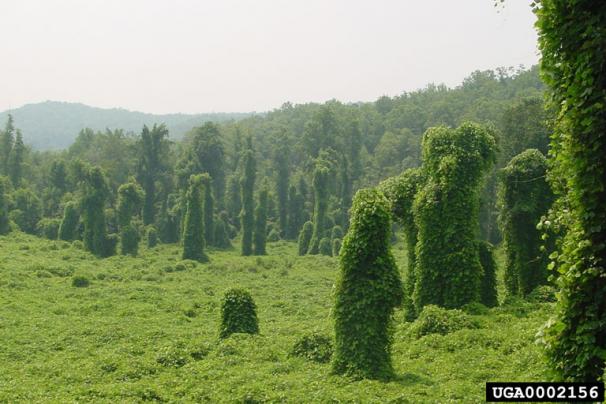Kudzu

Description
Kudzu is a climbing, semi-woody, perennial vine in the pea family. Deciduous leaves have three broad leaflets up to 4 inches across. Leaflets lobed with hairy margins. Individual flowers, about 1/2 inch long, are purple, highly fragrant, and borne in long hanging clusters. Flowering occurs in late summer and is soon followed by the production of brown, hairy, flattened, seed pods, each of which contains three to ten hard seeds.
Threat
Kudzu kills other plants by smothering them under a blanket of leaves and by breaking branches or uprooting entire trees and shrubs through the sheer force of its weight. Kudzu plants grow rapidly, extending as much as 60 feet per season at a rate of about one foot per day.
This vigorous vine may extend up to 100 feet in length, with stems up to 4 inches in diameter. Kudzu roots are fleshy, with massive tap roots 7 inches or more in diameter, 6 feet or more long, and weighing as much as 400 pounds. As many as thirty vines may grow from a single root crown.
Treatment
As with many invasive species, kudzu often takes several years and multiple applications to fully control. Kudzu can be treated in several different ways, including repeated cutting of the new growth, grazing with livestock, digging the roots and crown up manually/mechanically, repeated disking, repeated controlled burning, and repeated herbicide use. For best results and long-term control, it is best to combine these methods when possible.
Herbicides proven to control kudzu in the past include herbicides containing:
Triclopyr (as in Triclopyr 4)
Picloram (as in Crossbow)
Metsulfuron Methyl (as in Escort)
The situational use of each chemical will vary based on the time of year, surrounding landscape, presence of water, soil type, and desired outcome. Over-the-counter herbicides are available for DIY treatment online and at local farm and garden stores. Always follow herbicide label directions when applying. For larger treatment areas or biologically sensitive areas, it is best to enlist the help of a licensed herbicide applicator and (in forestry situations) a registered forester.
Alternative Plants
The following plants have flowers and fruits, provide food for wildlife, and make excellent substitutes for kudzu:
- Trumpet creeper (Campsis radicans)
- Pipevine (Aristolochia macrophylla)
- Passionflower (Passiflora lutea)
- Trumpet honeysuckle (Lonicera sempervirens)
- Native bittersweet (Celastrus scandens)
Kudzu Treatment Assistance Options
Two cost-share programs are currently run by the Mississippi Forestry Commission, which can be used for Kudzu treatment. Both programs require the applicant to first apply for program approval (must be approved by the MFC), then secure the services of an herbicide vendor, and finally pay the full amount due to the vendor. Once the work is completed and invoices are paid, each program allows for reimbursement of part of the cost of treatment (with proper documentation being provided). Funding for both programs is limited.
If a Mississippi private landowner has a kudzu problem in a forested situation and owns 10 or more contiguous forested acres, they may apply for cost-share assistance through the FRDP program. This is often the best option when treatment is needed during site-preparation activities while establishing a new stand of trees. To apply for FRDP, click the button below:
If a Mississippi private landowner needs kudzu treatment during mid-rotation forestry activities or has other kudzu issues in non-forested areas, they may apply for the Kudzu Treatment Program.
Once an application to either program has been received, it is placed on a waiting list. Applicants are contacted based on a first-come, first-served basis and available annual funding. Once contacted by the MFC, applicants can expect a site visit and further communications regarding the cost-share system process.
Contact MFC for More Information
For more information about kudzu in Mississippi, contact badplants@mfc.ms.gov.
